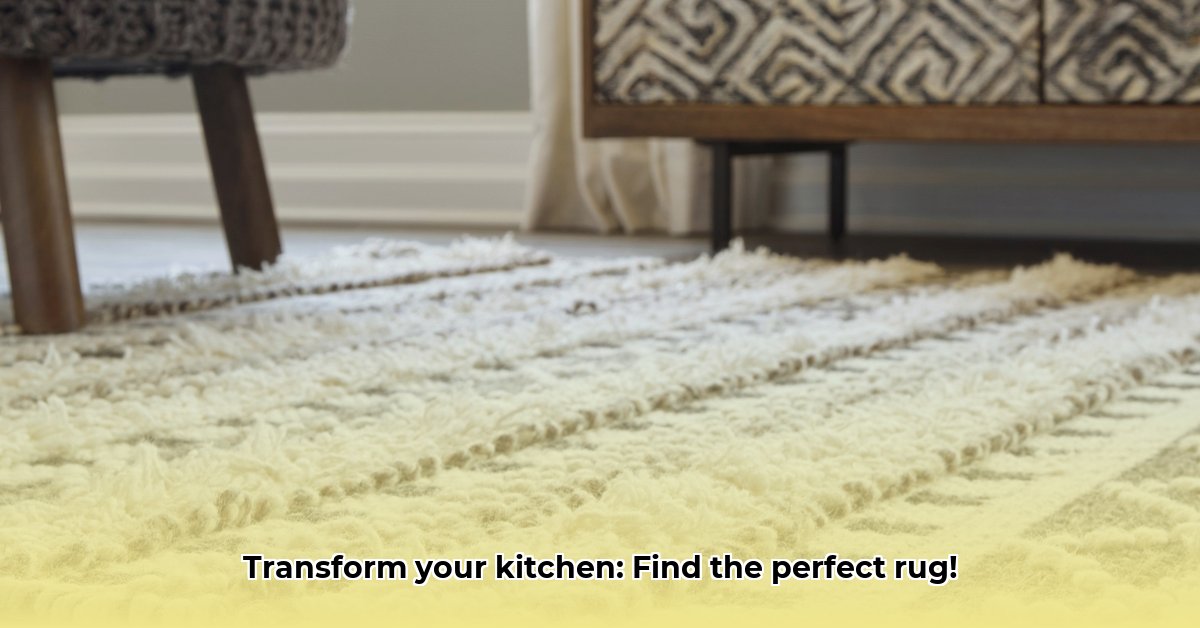Picking the right rug under your kitchen table can transform your entire dining experience, adding both style and practicality to your space. This comprehensive guide will walk you through the essential considerations, from sizing and material selection to maintenance tips, ensuring you find the perfect rug to elevate your kitchen. Think of it as a design upgrade and a functional necessity all rolled into one. For round tables, consider these round table top options.
Rug Under Kitchen Table: How to Choose the Best Option for Your Space
Selecting a rug for under your kitchen table involves balancing aesthetics with practical needs. This guide simplifies the process, offering clear steps and actionable advice to ensure you choose a rug that complements your kitchen’s design while standing up to daily wear and tear creating an inviting and comfortable space. You’ll be surprised how much a simple rug can change the feel of a room.
Sizing and Shape: Ensuring the Perfect Fit
The size and shape of your rug are paramount. A rug that is too small can look lost, while one that is too large can overwhelm the space. The ideal rug should extend at least 24 to 36 inches beyond each side of your table, allowing chairs to slide in and out easily without catching the edge. This seemingly minor detail can significantly enhance the comfort and flow of your dining area. Don’t forget to select a shape that complements your table whether it’s round, oval, rectangular, or square.
Matching the rug’s shape to your table is also important for visual harmony. A circular table typically looks best with a round or oval rug, while rectangular or square tables pair well with rectangular or square rugs. Consider the overall shape of your dining area as well. In a smaller space, sticking to the same shape as the table can create a more cohesive look. In a larger dining room, you might experiment with different shapes to add visual interest.
For a rectangular table that seats six, which is approximately 36 inches wide by 60 inches long (3 by 5 feet), a rug that is 7 by 9 feet would be ideal. This allows for about 2 feet of rug extending beyond each side of the table.
Material Selection: The Right Rug Material for Your Lifestyle
Your lifestyle plays a crucial role in determining the best rug material. Consider factors such as foot traffic, the presence of kids and pets, the frequency of dinner parties, and your personal cleaning habits. This ensures that you select a material that not only looks great but also withstands the demands of your daily life. About 60% of homeowners prioritize easy-to-clean materials when selecting rugs for high-traffic areas. In households with small children, stain resistance and washability are even more important considerations.
- Synthetic fibers like polypropylene, nylon, and polyester are durable, stain-resistant, and easy to clean, making them ideal for busy kitchens. Many are also fade-resistant, making them suitable for areas with lots of sunlight.
- Natural fibers like wool and jute offer natural elegance but require more care and are more prone to staining. Wool, however, is naturally stain-resistant to some degree and very durable if properly maintained.
- Blended fibers, which combine natural and synthetic materials, provide a balance of both worlds offering durability with a touch of natural softness and texture
- Low-pile rugs are generally easier to clean and maintain regardless of the material, making them a practical choice for a kitchen rug. Low pile also minimizes tripping hazards.
| Material | Advantages | Disadvantages | Perfect For |
|---|---|---|---|
| Polypropylene | Durable, stain-resistant, budget-friendly, water-resistant, fade-resistant | Can feel less soft than natural fibers, may flatten over time in high-traffic areas | High-traffic kitchens, families with kids/pets, areas prone to spills |
| Nylon | Soft, durable, stain-resistant, resilient | Can be pricier than polypropylene, may generate static electricity | High-traffic areas, those desiring softness and durability |
| Polyester | Stain-resistant, budget-friendly, soft | Less durable than nylon or polypropylene, may shed fibers | Low-to-medium traffic areas, those seeking a soft and affordable option |
| Wool | Luxurious, naturally stain-resistant (to a degree), durable, flame-resistant | More expensive, needs more care, can be damaged by moths if not properly treated | Formal dining areas, sophisticated styles, those prioritizing natural materials and durability |
| Jute | Eco-friendly, durable, natural look | Can stain easily, special care needed, rough texture, sheds fibers | Casual dining, rustic décor, those seeking a natural, textured look, but willing to take extra care |
| Sisal | Durable, textured | Stains easily, difficult to clean, rough texture | Similar to jute, but even more prone to staining, best in low-spill environments |
| Blended Fibers (e.g. Wool-Nylon) | Combines benefits of both materials | Properties depend on the ratio of each fiber; may still require specialized cleaning | Those seeking a balance of durability, stain-resistance, and luxurious feel |
Integrating with Your Kitchen Decor: Color and Pattern Coordination
The rug should complement your existing flooring and overall kitchen decor. A rug can add warmth to cool tile floors or soften the feel of hardwood. Select a color and pattern that aligns with your kitchen’s color scheme and creates a cohesive visual flow. Consider the style of your kitchen: a modern kitchen might benefit from a geometric pattern or a bold solid color, while a traditional kitchen might look best with a classic Persian or floral design.
Don’t forget a rug pad that prevents slipping, protects your floors, and extends the life of your rug. Rug pads have a high success rate in preventing slippage and extending a rug’s lifespan. Look for rug pads made from natural rubber or felt, which are both eco-friendly and effective.
Maintenance Tips: Simple Methods for Long-Lasting Beauty
Regular maintenance is essential to keep your rug looking its best. Vacuum at least once a week to prevent dirt accumulation and address spills immediately with a clean, absorbent cloth. For liquid spills, blot from the outside in to prevent spreading. Consider professional cleaning every year or two for deeper cleaning. For wool rugs, professional cleaning is highly recommended to avoid damage.
Actionable Framework:
- Vacuum Regularly: At least once a week, and more often in high-traffic areas, to prevent dirt buildup. Use a vacuum with a brush attachment for best results.
- Address Spills Immediately: Blot (don’t rub) with a clean, white cloth (high success rate for stain removal when done quickly). For stubborn stains, use a mild detergent diluted with water.
- Rotate Regularly: Rotate your rug every few months to ensure even wear and prevent fading in areas exposed to sunlight.
- Professional Cleaning: Consider professional cleaning every 1-2 years for deep cleaning, especially for wool or delicate rugs.
- Use Rug Protectors: Place rug protectors under furniture legs to prevent indentations and wear.
Summary: The Ideal Kitchen Rug for Comfort
Choosing the right rug for under your kitchen table is a thoughtful process. By considering your lifestyle, design preferences, and the practical advice outlined above, you can find a rug that is both beautiful and functional, transforming your kitchen into a space that reflects your personality and enhances your dining experience. It’s about making your kitchen not just a place to cook, but a place to truly live.
Optimizing Rug Choices: Stain-Resistant Designs for Dining Room Rugs
Selecting stain-resistant dining room rugs for high-traffic areas is vital for maintaining both style and practicality. This section details how to choose a rug that withstands heavy use while preserving its aesthetic appeal, ensuring your dining room remains elegant irrespective of daily wear. Remember that you can balance elegance and practicality in any high-traffic area.
Assessing Your Needs: Understanding Traffic and Lifestyle
Before choosing materials, consider your lifestyle and the specific demands of your dining area. Do you have kids or pets? How often do you host dinner parties? What types of food are commonly eaten in the dining room? These factors directly influence the durability and stain resistance required for your rug. A higher frequency of use necessitates a more robust, easily cleaned rug.
Material Matters: Pros and Cons of Top Choices
The material of your rug significantly impacts its lifespan and ease of maintenance. Here’s a comparison of popular options for high-traffic dining areas:
| Material | Pros | Cons | Suitability for High-Traffic Areas | Stain Resistance |
|---|---|---|---|---|
| Nylon | Durable, stain-resistant, relatively inexpensive, easy to clean, resists mildew and fading | Can feel slightly less luxurious than wool, may generate static | Excellent | Excellent |
| Polypropylene | Highly stain-resistant, water-resistant, budget-friendly, easy to clean, resists mildew | Can feel less soft than wool or nylon; may not be as durable as nylon, can be prone to melting under high heat | Excellent | Excellent |
| Wool | Naturally stain-resistant (due to lanolin), durable, luxurious feel, flame-resistant | More expensive; requires more meticulous cleaning; susceptible to |
- Modern Kitchen Backsplash Ideas To Inspire Your Refresh - December 19, 2025
- Modern Backsplash Ideas: A Guide to Todays Kitchen Trends - December 18, 2025
- Ceramic Kitchen Wall Tiles: Style and Protection for Your Walls - December 17, 2025









